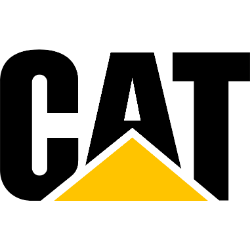Caterpillar demonstrates strong business quality through solid financial performance, robust cash flow, and a diverse market presence, although it faces challenges with declining sales volume. Future prospects are mixed, with growth anticipated in certain sectors, but overall sales are expected to decline slightly in 2025 amid ongoing economic challenges.
Analysis Date: January 30, 2025
Last Updated: March 11, 2025
Trailing Twelve Months (TTM) values provide a view of the company's performance over the last year.
Graham Value Metrics
Benjamin Graham's value investing approach focuses on finding stocks with a significant margin of safety between their intrinsic value and market price.
Intrinsic Value
Estimated fair value based on Graham's formula
$858.10
Current Market Price: $284.35
IV/P Ratio: 3.02x (>1.0 indicates undervalued)
Margin of Safety
Gap between intrinsic value and market price
67.0%
Graham recommended a minimum of 20-30% margin of safety
Higher values indicate a greater potential discount to fair value
ROE: 58.60678550579035
ROA: 3.1801194111480786
Gross Profit Margin: 36.06289249949853
Net Profit Margin: 16.65200820873644
Trailing Twelve Months (TTM) values provide a view of the company's performance over the last year.
Strong Return on Equity
CAT's return on equity of 58.61% demonstrates impressive profitability and effective management of shareholder equity.
Healthy Profit Margins
With a net profit margin of 16.65%, CAT shows strong profitability, indicating effective cost management and robust sales performance.
No profitability weaknesses identified.
About Profitability Metrics
Profitability metrics measure a company's ability to generate earnings relative to its revenue, operating costs, and other relevant metrics. Higher values generally indicate better performance.
Return on Equity (ROE)
Measures how efficiently a company uses its equity to generate profits
58.61%
10%
15%
Higher values indicate better returns for shareholders
TTM (as of 2025-04-16)
Return on Assets (ROA)
Measures how efficiently a company uses its assets to generate profits
3.18%
3%
7%
Higher values indicate better asset utilization
TTM (as of 2025-04-16)
Gross Profit Margin
Percentage of revenue retained after accounting for cost of goods sold
36.06%
20%
40%
Higher values indicate better efficiency in production
TTM (as of 2025-04-16)
Net Profit Margin
Percentage of revenue retained after accounting for all expenses
16.65%
8%
15%
Higher values indicate better overall profitability
TTM (as of 2025-04-16)
Strong Interest Coverage
An interest coverage ratio of 26.02 indicates that CAT can comfortably meet its interest obligations, suggesting strong financial health.
Decent Current Ratio
With a current ratio of 1.42, CAT maintains adequate liquidity to cover its short-term liabilities.
High Debt to Equity Ratio
The debt to equity ratio of 1.97 indicates a high level of leverage, which may pose risks in a downturn or if interest rates rise.
Low Cash Ratio
A cash ratio of 0.21 suggests that CAT has limited cash available to cover its current liabilities, which may impact liquidity in crisis situations.
About Financial Health Metrics
Financial health metrics assess a company's ability to meet its financial obligations and its overall financial stability.
Debt to Equity Ratio
Total debt divided by total equity
1.97x
1.0x
2.0x
Lower values indicate less financial leverage and risk
Less than 1.0 is conservative, 1.0-2.0 is moderate, >2.0 indicates high risk
Q4 2024
Current Ratio
Current assets divided by current liabilities
1.42x
1.0x
2.0x
Higher values indicate better short-term liquidity
Less than 1.0 is concerning, 1.0-2.0 is adequate, greater than 2.0 is good
Q4 2024


